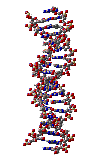
seeking permission from U
of Oklahoma (animation)
Earth is the only known place in the universe with life.
What is life?
How do living things effect their environment?
How do species adapt to their environment?
How did life get started?
Is life unique to earth?
These are all interesting questions we will examine (some without conclusive
answers).
Metabolism - Interactions with the environment by physical and chemical processes by which energy from the outside world is used in such activities as reproduction, growth, locomotion, and responsiveness to the environment.
Reproduction - The ability to self replicate in order to maintain the species. All known life uses certain large molecules called DNA (Deoxyribonucleic acid) to store genetic information. This is the "code" used by every generation to maintain the species.

seeking permission from U
of Oklahoma (animation)
DNA molecule - the code of life!
The DNA sequencing in a human consists of over 3 billion chemical building blocks. These "blocks" are actually nucleotides consisting of sugar, ribose, phosphate and one of the four nitrogen bases - adenine, guanine, cytosine or thymine (A, G, C, T) in the 23 different pairs of human chromosomes (containing an estimated 20,000 - 25,000 human genes). Each cell in your body contains this code! To learn more, check out the human genome project.
In the original double helix, the two separate strands are linked together because the bases pair up using this rule: T matches with A ... C matches with G.
This diagram depicts a tiny section of DNA (helix structure isn't depicted because it is too hard to draw). When it divides, each strand is originally unpaired ... but not for long. From the genetic material available in the cell, each unpaired base finds its base pair compliment. That is, every T finds an A, every G finds a C, etc. until the entire code is replicated. This leaves two copies of the genetic code ... one for each cell (after division).
Different sections of DNA contain segments called genes. Each gene is a code (like software) to give the cell instructions on what to do, how to do it, and when to do it. Pretty remarkable stuff.
If interested click here for more.
Life is generally divided into 5 kingdoms (all using DNA to replicate), but you are familiar with these two:
Plants - The energy source is the radiant energy of the sun, converted to a usable form by photosynthesis.
Animals - The energy source is chemical energy of ingested food.
The other 3 are Monera (some simple bacteria), Protista (amoebae & algae) &
Fungi
Generally speaking, any particular species can only survive within a very
narrow range of environmental conditions. That is, if you place humans in
conditions much different from the ones we are acclimatize to, we will not
survive. The same can be said of most all other species.
It appears all you need is water, energy, organic molecules and you find life. There are an estimated 10 million - 100 million ?? different species living on the earth presently (over 1.75 million species has already been catalogued).
To survive, species must be able to adjust to changes in their environment (or migrate to another area). If they can't, they become extinct. Many of the tropical birds in Hawaii have become extinct in just one century (probably because man has invaded their environment).
We know that the earth is dynamic and in a constant state of change. When an environment changes, the life forms in that environment are stressed to change as well. Some variables producing this stress can be a climatic change, changes in foliage, change in food supply, disease, competition for space and food with other species, lack or abundance of predator/prey or change is the species population itself. The fossil record indicates that the earth has gone through a series of mass extinctions. Several of these events correlate to periods of major climatic change (ice ages) where the extinction rate was over 95% of all the species on earth at the time. Others are brought on by other events, such as a meteor impact 65 million years ago marking the end of the Cretaceous Period (as well as the dinosaurs ... and 2/3 of all species on earth.) or possibly intense periods of volcanism.
Here are a few major extinction events:
Snowball Earth - 2.4 billion years ago. Cause - drop in greenhouse gas methane?
The Oxygen Holocaust - Photosynthesis appeared well before ~3.5 billion years ago, and "poisoned" the atmosphere about 2.0 billion years ago with its waste product, oxygen. This is because earlier life forms adapted to a chemically "reducing" environment. With oxygen present, the world becomes an "oxidizing" environment - lethal to these earlier life forms. Although anaerobic bacteria (live in an oxygen free environment) still survive, they represent a mast minority. This was probably the greatest mass extinction event in all time.
Snowball Earth - 600 and 750 million years ago - cause - change in axis tilt or drop in CO2 (greenhouse gas) ?
The Ordovician Extinction - 440 million years ago when over ⅔ of all species went extinct. This was a period most geologists believe was associated with a snowball earth which could have been triggered by a local supernovae explosion (a star blows up) which resulted in a major drop in atmospheric ozone ... allowing solar ultraviolet radiation to wreak havoc on life.
Major impacts - 65 million years ago (K/T Event or Cretaceous-Tertiary extinction) which doomed the dinosaurs as well as ⅔-¾ of all species on earth at the time. Other mass extinction event about 250 million years ago also appears to be from an impact. This event, known as the Permian-Triassic extinction, eliminated 95% of the species on our planet. Many of these impacts could also have been followed by periods of massive volcanism because the impact would seriously weaken the crust ... allowing greenhouse gasses to suddenly warm up the earth. Another impact may have lead to a mass extinction during the "age of fishes" 380 million years ago. Finally, 700,000 years ago, an impact almost wiped out mankind. (clues found from tektites in Australia ... this event caused major stress on the human population).
Periods of intense volcanism? - Maybe the Permian-Triassic extinction (aka: "the great dying" ... 250 million years ago) had nothing to do with an impact, but just a period of intense volcanoes in Siberia. The rise in greenhouse gasses caused a global sauna. There are lots of ideas related to this model. Let me expand on one. Ok, so the oceans get warmer as a result of a warmer earth. Warmer water has a lower ability to hold oxygen so most of the fish die out. Without oxygen in the water, anaerobic bacteria thrive which emit hydrogen sulfide (a poisonous gas). This gas then permeates the water and eventually pollutes the atmosphere as well. The gas then also kills life on the land. Although still highly debatable, computer models show that things like this could very well happen. The scary thing about this idea is that we may be repeating the same scenario right now (with massive CO2 emissions from fossil fuels) !!!!
Super Continents (Pangaea ~200 million years ago and Rodinia ~ 543 million years ago) Large landmasses (especially if near a pole) made the land interior dry and subject to extremes in temperature and also placed stress on marine environments due to diminished coastline areas. The extinctions may also have resulted from massive volcanism which occurred as these super continents broke up. This would have produced a huge increase in greenhouse gasses ... causing the earth to suddenly warm up.
If interested, read this article about mass extinctions by Andrew Alden or click here for some great links to extinction articles or click here for yet another article.
In contrast the ‘Cambrian Explosion’ of approximately 540 million years ago brought on a rich growth of new species.
Some
biologists believe we are currently in a global extinction phase now.
There are estimates that within our lifetime, 25% of all species may become
extinct (mostly due to the continued loss of the tropical rain forests).
These estimates are based on very sketchy data.
Timeline of Life on Earth - If the entire planets history were compressed into a single year, we would find:
Jan. 1 - Earth
formed (~ 4.5 - 4.6 billion years ago)
Feb. 26 - Chemical evidence of life (~ 3.8 billion years ago?)
Mar. 22 - Earliest fossil prokaryotes (~3.5 billion years ago ... or even
earlier)
Jul. 1 - Cyanobacteria raise the oxygen content of the atmosphere (~2.25 billion
years ago)
Jul. 13 - Earliest eukaryotes (~2.1 billion years ago)
Oct. 4 - First multicellular organisms (700 million years ago)
Oct. 17 - Cambrian “Explosion” (~540 million years ago)
Oct. 28 - Amphibians colonize land (~400 million years ago)
Nov. 11 - Permo-Triassic extinction (250 million years ago ... possible impact
of a comet or asteroid with earth)
Nov. 14 - Dinosaurs take over land (~215 million years ago)
Dec. 26 - KT extinction - Dinosaurs are out ... mammals are in (65 million years ago ... impact of
comet or asteroid with earth)
Dec. 31, Noon - Human ancestors diverge from the apes (~6 million years ago)
Dec. 31, 8:50 PM - Man the tool user (Homo Habilis) and traveler (2 million
years ago)
Dec. 31, 10 PM - Homo erectus appears – fire and better tools
Dec. 31, 11:37 PM - Archaic modern humans appear
Dec. 31, 11:56:30 - Modern humans take over.
Dec. 31, 11:59:18 - Pyramids build in Egypt
Dec. 31, 11:59:58.6 - Industrial revolution
The first billion years on the earth would have been very hostile for life to survive. This is the period known as: The Time of Heavy Bombardment. The young solar system was just forming from debris swirling around a young star. Impacts took place that helped form the earth, but would have been too violent for any life forms to survive.
As soon as the solar system was stable, and the earth was cool enough for liquid water to appear ... life happened! The records show that it formed remarkably quick, but the first life forms were very simple.
For most of the earth's history, life was very simple - single celled bacteria called Prokaryotes. These cells did not have a nucleus (center part where normal DNA works) and were anaerobic -- that is, they lived in the absence of oxygen. As an energy source, they used sulfur compounds that were emitted from hydrothermal vents on the ocean floor. Life could only survive under water because, without oxygen, there is no ozone (O3) ... and the surface (if it even existed back then) would have been flooded by deadly UV radiation from the sun. A byproduct of these early life forms was hydrogen sulfide ... which has the odor of rotten eggs. The early earth stunk!
One bacteria, Cyanobacteria, found a new energy source -the sun! This was the first photosynthetic life forms and it changed everything. These bacteria produced oxygen as a byproduct (which was deadly to earlier life forms) about 3.5 - 3.75 billion years ago. Basically not much changed (in terms of life) for a very, very, very long time!

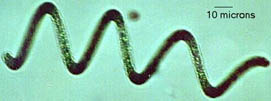
Cynobacteria
Life became a bit more complex about 2.1 billion years ago with the advent of Eukaryotes. These were single celled bacteria but their cells were more structured. These cells had individualized parts to carry out specific functions. One example is the nucleus .. the centralized part that only has one job ... replication of DNA and cell division. With this strategy, life was able to move forward to more advanced forms.
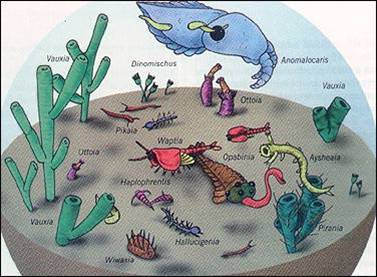
The Cambrian Explosion
About 540 million years ago came the “Cambrian Explosion” - when things really took off. But why? The planet just came out of a great ice age. The Verangian ice age occurred about ~600 million years ago where glaciers extending to near the equator. The planet was nearly frozen solid. Organisms were under enormous environmental stress. Was that the cause of the diversification of life??? Also, plate tectonics could have played a role.
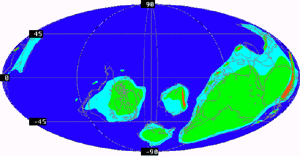
On the earth, the formation of the super continent, Rodinia (the one before Pangaea), severely restricted shallow marine environments. This forced species into intense direct competition for survival. It was survive or die! So it became a great advantage to find ways to compete. There are no concrete answers at this time. For whatever the reason, a great diversification of life took place.
We discussed this in the last section but here is a review:
Precambrian Era - Ancient Life - simple organisms with soft bodies (so the fossil record is sketchy)
Paleozoic Era - Early Life, "Age of Fishes" - 250 - 570 million years ago
Mesozoic Era - Middle Life, "Age of Dinosaurs" - 65 - 250 million years ago
Cenozoic Era - Modern Life, "Age of Mammals" - 0-65 million years ago
Parts copied (with permission) from Dr. Pamela J. W. Gore, Georgia Perimeter College, Georgia at http://www.gpc.edu/~pgore/geology/geo102/evol.htm
This principle can be succinctly stated as "the survival of the fittest". In any population, there will be individuals that are slightly more tolerant of changes in the limiting factors of the environment. When environmental conditions change, bringing individual organisms near their limits of tolerance, there will always be a few which are at least slightly more tolerant or BETTER ADAPTED than the population as a whole. The better adapted individuals will survive to reproduce. This passes along favorable traits to their offspring. The environment "selects" the best adapted individuals, hence the term "natural selection".
Genetic mutations produce much of the variability on which natural selection operates. These mutations in the genetic code may be brought on by radiation or by a chemical substance. It is painfully apparent that these mutations exist ... just look at all the mutations which produce genetic "failures" - Cystic Fibrosis, Sickle Cell, color blindness, Huntington's disease, (the list is very long ... nearly 4,000 diseases). The mutations that natural selection depends on are genetic "successes" where a favorable trait is passed on.
There are several examples of changes within populations going on today. They include:
Natural selection does not work on short time scales. It is an extremely gradual shift in the gene pool that may take thousands of generations to notice. Fortunately, some species have very short life cycles (bacteria) which give scientists a change to see this happen on human time scales.
The bad news for humans (based on the fossil evidence) is ... most species
have a finite life span. What will bring on the demise to man? Many
think we will be the tool of our own destruction! However, I believe
our special "survival trait" is our ability to think our way out
of danger. Can humans survive by this? I hope so.
This is one of the great unsolved mysteries of science. Perhaps it will always remain a puzzle.
If interested, click this great link.
If interested, read this interesting article by Christian de Duve
The main points are:
Could the "seeds" of life on earth originate from other places in the universe? One theory - called Panspermia (or Cosmic Ancestry) thinks so. Read this, ... it is a very interesting (but very long) web page. The theory does not attempt to explain how life originally got started.
Here are some interesting articles you should look over.
Life on Earth Came Earlier, Crystal Evidence Suggests
On November 2000, astrobiologists claimed that they found evidence that
life was found on land 2.6 billion years ago ... much earlier than
once thought. Click
here
to read more about it.
To this point, the earth is the only known place where life exists, but recent events have been cause for heated debate.

A picture of
ET?
Credit NASA
Several biologists claimed that these features were too small (nanobacteria)
to be life but the debate heated up again when similar sized micro fossils
were discovered in deep earth rocks. Click
here
for the story and also
here
to learn about nanobacteria. The debate continues but in March 2002,
scientists found ways of producing the same features by heating and shocking
similar type rocks in the lab. Certainly any rock blasted off Mars (and
plunging through our atmosphere) would have undergone similar conditions.
The only way to know for sure is to land on Mars, return local rocks to Earth,
... and examine them in the lab.
In 1998, Researchers at Glasgow University say a huge rock formation on the planet's surface is probably a giant fossil created billions of year ago by microbes (similar to stromatolite formations found on earth). Click here for the story.
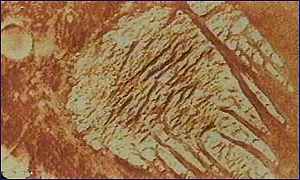 An aerial view of
Martian fossils?
An aerial view of
Martian fossils?
Credit NASA
The failure of the Martian Polar Lander (December 1999) will delay the debate since this probe was to study the ice caps of Mars (a possible home for any existing life forms on that planet).
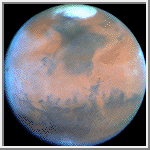
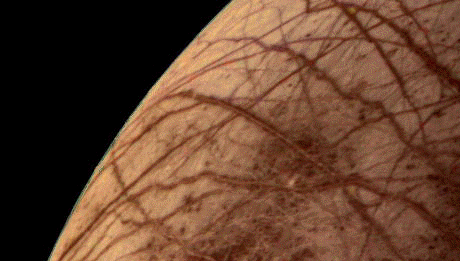
There is strong evidence that this moon could harbor oceans of liquid water below its ice capped surface. Is this the place to look for life?
Click
here
for the story.
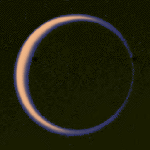
This moon of Saturn is the only one with a thick atmosphere ... with organic rich molecules yet. Could it hold life? Probably not (too cold for biologic activity) but it could give us insight to what the early earth was like. The Cassini (Huygens) space probe visited Titan in 2004. Click here for the story.
Life in our solar system link
Are we looking for life outside the solar system? You bet. Two projects, Serendip and Project Phoenix are two attempts to receive radio signals from extra terrestrial sources. None has yet received any proof that ET exists - but just wait!
Maybe the
first step in finding extraterrestrial life is to find another earth-like planet
outside our solar system. Keep your eyes open for the launching of
Project Darwin scheduled for 2015. This system of space telescopes may
actually find indirect evidence of life if a planet is found with a substantial
amount of ozone in its atmosphere. This is also the goal of a NASA mission
known as the
Terrestrial Planet Finder planned for launch in 2014. I believe we
will witness the discovery of "earth's twin" within my lifetime.
©Jim Mihal 2004, 2006 - all rights reserved